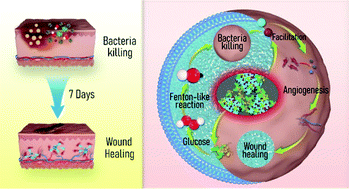Bimetal metal–organic framework domino micro-reactor for synergistic antibacterial starvation/chemodynamic therapy and robust wound healing†
Abstract
Antibacterial chemodynamic therapy (aCDT) has captured considerable attention in the treatment of pathogen-induced infections due to its potential to inactivate bacteria through germicidal reactive oxygen species (ROS). However, the lifespan of ROS generated by CDT is too short to achieve the efficacy of complete sterilization; thus, residual bacteria inevitably reproduce and cause super-infections. To address this concern, we devise an innovative bimetal, metal–organic framework (BMOF) domino micro-reactor (BMOF-DMR), consisting of Cu/Zn-rich BMOF and glucose oxidase (GOx), via electrostatic self-assembly. GOx catalyzes conversion of glucose into H2O2, and the Cu2+ ions then convert H2O2 into ˙OH to kill bacteria, thereby showing a domino effect. Accordingly, the BMOF-DMR not only blocks the nutrient/energy supply for bacteria, but also triggers a Fenton(-like) reaction and glutathione (GSH) depletion in a self-generating H2O2 microenvironment, all leading to high-efficiency bactericidal performance through synergistic starvation/chemodynamic therapy. Remarkably, in vitro and in vivo assessments demonstrate that the BMOF-DMR has superior cytocompatibility and exhibits robust ability to accelerate infectious full-thickness cutaneous regeneration through eradicating bacteria, promoting epithelialization of the wound beds and facilitating angiogenesis from the antibacterial activity and delivery of bimetal elements. The advantage of this antibacterial platform is that it suppresses bacterial metabolism by blocking the energy supply, which might prevent secondary infections from residual bacteria. As envisaged, the use of such a micro-reactor with starvation/chemodynamic therapy is a promising approach for combating bacterial skin wounds.

- This article is part of the themed collection: Nanoscale 2023 Lunar New Year Collection


 Please wait while we load your content...
Please wait while we load your content...